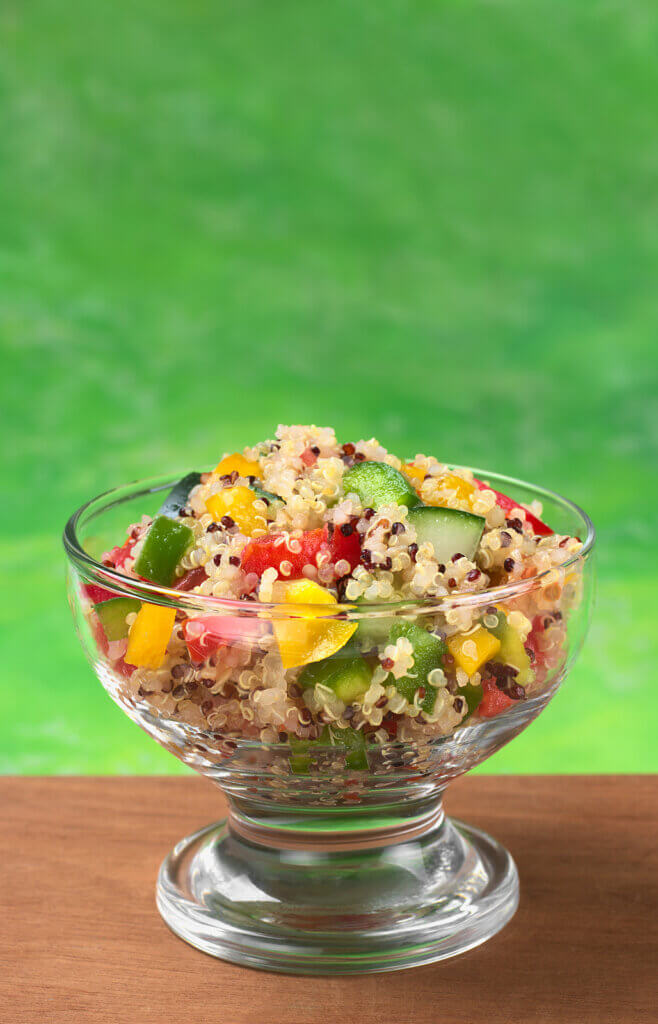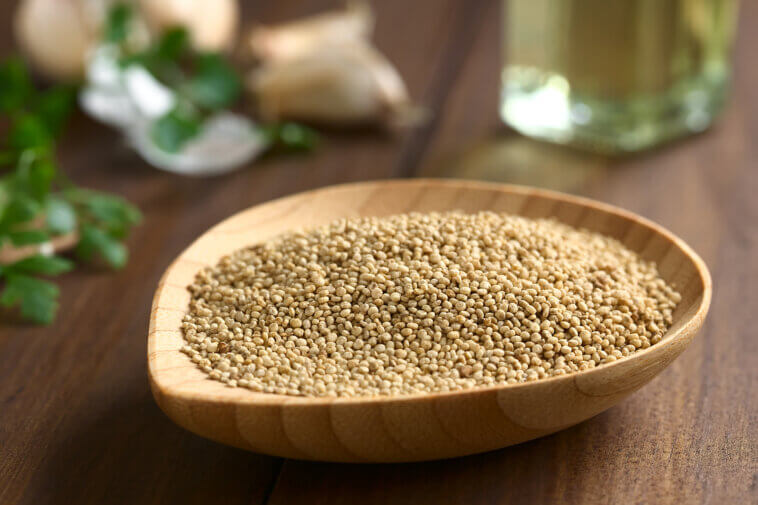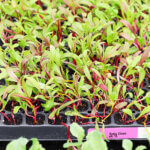Table of Contents
In the past few years, I've been truly amazed by the growing popularity of microgreens, especially quinoa microgreens, in the health-conscious community. These little green powerhouses have taken the nutrition world by storm, and I can't help but share my excitement about them. Quinoa microgreens are a nutritional dynamo, and I believe they should be a staple in everyone's daily diet.
So, let's dive into this comprehensive guide where I'll walk you through everything I've learned about quinoa microgreens – from cultivating them to the incredible health benefits they offer, and of course, some mouthwatering ways to include them in your meals. Let's embark on this flavorful journey together!
What Are Quinoa Microgreens?
Quinoa microgreens, derived from the sprouted seeds of the quinoa plant (Chenopodium quinoa), offer a fascinating glimpse into the world of nutrition and flavor. Quinoa, a gluten-free grain celebrated for its remarkable protein content and well-balanced amino acid composition, serves as the source of these vibrant and youthful greens.
The process of cultivating quinoa microgreens involves germinating quinoa seeds and allowing them to grow for a brief period, typically spanning 7 to 14 days. During this relatively short growth cycle, the quinoa seeds undergo a remarkable transformation, giving rise to quinoa microgreens.
These tender and delicate greens are not only visually appealing but also brimming with an array of essential nutrients. Their flavor profile is intense, making them a delightful addition to various culinary creations. The combination of quinoa's inherent nutritional benefits and the unique characteristics of its microgreens makes them a noteworthy addition to any diet.
Why Choose Quinoa Microgreens?
There are several compelling reasons to choose quinoa microgreens as a valuable addition to your diet, and exploring their nutritional profile and ease of cultivation further emphasizes their appeal.
Nutritional Profile
Quinoa microgreens stand out primarily due to their exceptional nutritional content. These diminutive greens are a treasure trove of essential vitamins and minerals that can significantly contribute to your overall health. They are notably rich in vitamins A, C, E, and K, each playing distinct roles in supporting various aspects of well-being. For instance, vitamin A promotes healthy vision and skin, while vitamin C enhances immune function and encourages collagen production for vibrant and youthful skin. Vitamin E acts as a potent antioxidant, safeguarding your cells against oxidative damage, and vitamin K plays a crucial role in blood clotting and bone health.
In addition to these vitamins, quinoa microgreens offer essential minerals such as calcium, magnesium, and iron. Calcium is vital for maintaining strong bones and teeth, while magnesium is involved in numerous biochemical reactions within your body, including those related to muscle and nerve function. Iron is indispensable for the transportation of oxygen in your bloodstream and is pivotal in preventing anemia.
Easy to Grow at Home
One of the standout advantages of quinoa microgreens is their ease of cultivation, making them an attractive choice even for those with limited gardening experience or limited space. The following steps outline how you can successfully grow these nutrient-rich greens in the comfort of your own home:
- Select a Growing Container: Choose a shallow container or tray with good drainage to plant your quinoa microgreens. You can use pots, seed trays, or even repurpose items like old food containers with holes punched in the bottom for drainage.
- Prepare the Growing Medium: Fill your chosen container with a potting mix or a soilless seed-starting mix. Ensure the medium is well-moistened but not waterlogged.
- Sow the Quinoa Seeds: Sprinkle quinoa seeds evenly across the surface of the growing medium. Gently press them into the soil to ensure good seed-to-soil contact.
- Provide Adequate Light: Place the container in a location with plenty of indirect sunlight or use artificial grow lights. Quinoa microgreens thrive with about 6-8 hours of light daily.
- Watering and Care: Keep the soil consistently moist but not soggy. Watering from below by placing the container in a shallow tray of water can help prevent overwatering. Ensure good air circulation to discourage mold growth.
- Harvest: Quinoa microgreens are typically ready for harvest in 7-14 days when they reach a height of 2-3 inches. Use scissors or sharp shears to snip them just above the soil level.
Check out our post on Guide to Microgreens
Growing Quinoa Microgreens
Growing quinoa microgreens can be a rewarding and nutritious experience. To embark on this journey, it's essential to gather the right supplies and follow a step-by-step process. Here's a comprehensive guide that includes additional information to help you successfully cultivate quinoa microgreens at home:
Supplies You'll Need
Before you begin, gather the following supplies to ensure a smooth growing process:
- Quinoa seeds (preferably organic): Opt for high-quality quinoa seeds to yield the best results.
- A shallow container or tray: Select a container with adequate drainage to prevent waterlogged soil.
- Potting soil or a suitable growing medium: Ensure the soil is well-suited for seed germination and has good moisture retention properties.
- Water spray bottle: This will help you maintain the appropriate level of moisture for your microgreens.
- Plastic wrap or a clear plastic lid: Use this to create a greenhouse effect, promoting ideal growing conditions.
- A warm, well-lit location (indirect sunlight is best): Find a spot with consistent warmth and indirect sunlight for optimal growth.
- Water: To keep the soil adequately moist during the growing process.
Step-by-Step Growing Instructions
Follow these detailed steps to successfully cultivate your own quinoa microgreens:
- Prepare the Container: Fill the container or tray with potting soil, leaving approximately an inch of space from the top. Ensure the soil is evenly distributed.
- Sow the Quinoa Seeds: Sprinkle quinoa seeds evenly across the surface of the soil. Be mindful not to overcrowd the seeds, as this can hinder their growth potential.
- Press and Mist: Gently press the quinoa seeds into the soil to ensure good contact. Using the water spray bottle, mist the seeds lightly to moisten the surface.
- Create a Greenhouse Effect: Cover the container with plastic wrap or a clear plastic lid to trap moisture and create a greenhouse effect. This step helps maintain the optimal humidity and temperature for germination.
- Choose the Right Location: Place the container in a warm, well-lit area, but avoid direct sunlight, as it can be too harsh for young microgreens.
- Maintain Moisture: Regularly mist the soil surface to keep it consistently moist but not waterlogged. Ensure the container has proper drainage to prevent overwatering issues.
- Harvest: In about 7-14 days, when the quinoa microgreens have reached a height of 2-3 inches, they are ready for harvest. Use scissors to cut them just above the soil surface, and they are ready to be enjoyed.
Common Mistakes to Avoid
To ensure your quinoa microgreens thrive, be aware of common mistakes that can hinder their growth:
- Overwatering: Avoid excessive watering, as it can lead to mold growth and root rot.
- Lack of Light: Ensure your microgreens receive enough indirect sunlight or artificial light for healthy growth. Insufficient light can result in leggy, weak microgreens.
- Crowding Seeds: Be mindful not to overcrowd the seeds during sowing. Proper spacing allows each seedling to grow without competition, promoting healthier development.

Health Benefits of Quinoa Microgreens
Rich in Nutrients
The outstanding nutrient content of quinoa microgreens makes them a standout choice for health-conscious individuals. Beyond vitamins and minerals, these greens are also rich in other essential nutrients like folate, which is crucial for DNA synthesis and cell growth. Additionally, they provide a good source of dietary fiber, which aids in digestion, supports a feeling of fullness, and promotes regular bowel movements.
Antioxidant Properties
Quinoa microgreens are packed with antioxidants, which are compounds that help protect your cells from damage caused by free radicals. Free radicals are unstable molecules that can harm your DNA, proteins, and lipids, potentially contributing to chronic diseases like cancer and heart disease. The antioxidants in quinoa microgreens, including beta-carotene and flavonoids, help neutralize these harmful molecules, reducing your risk of such diseases.
Digestive Health
The dietary fiber found in quinoa microgreens is essential for maintaining good digestive health. Fiber adds bulk to your stool, making it easier to pass and preventing constipation. Moreover, a diet rich in fiber supports the growth of beneficial gut bacteria, promoting a healthy gut microbiome. A balanced gut microbiome is associated with numerous health benefits, including improved digestion and a strengthened immune system.
Anti-Inflammatory Effects
Chronic inflammation is thought to be a contributing factor to many diseases, including heart disease, diabetes, and autoimmune conditions. Quinoa microgreens contain phytonutrients with anti-inflammatory properties, potentially reducing the risk of these inflammation-related diseases. These phytonutrients can help calm inflammation within the body and support overall health.
Incorporating Quinoa Microgreens Into Your Diet
Salads and Wraps
One of the simplest and most popular ways to enjoy quinoa microgreens is by adding them to salads and wraps. Their vibrant green color and slightly peppery, nutty flavor complement a wide range of ingredients. Simply sprinkle a handful of quinoa microgreens on top of your favorite salad or tuck them into a wrap for added texture and nutrition.
Smoothies and Juices
Quinoa microgreens make an excellent addition to your morning smoothies or freshly pressed juices. Their mild flavor won't overpower the drink, but their nutritional value will give you an energy-packed start to the day. Whether you're blending a green smoothie with spinach and kale or opting for a fruit-based concoction, tossing in some quinoa microgreens is a smart move for a health boost.
Sandwiches and Tacos
Upgrade your sandwiches and tacos by layering quinoa microgreens into them. Their delicate texture and fresh flavor provide a satisfying crunch and elevate the overall taste of your dishes. Swap out regular lettuce for quinoa microgreens to infuse your meals with a nutritious twist.
Garnish for Soups and Entrees
Quinoa microgreens make an elegant garnish for soups, pasta dishes, and grilled entrees. Their vibrant green color and delicate texture can enhance the presentation of your meals while adding a burst of flavor and nutrition. Sprinkle a handful of quinoa microgreens over a bowl of soup or on top of a pasta dish just before serving to impress your guests or elevate your dining experience at home.
Quinoa Microgreens vs. Regular Quinoa
While quinoa microgreens and mature quinoa share a common origin, they offer distinct advantages and applications:
Nutrient Density
Quinoa microgreens are more nutrient-dense compared to mature quinoa. During their rapid growth phase, microgreens concentrate essential vitamins and minerals in higher amounts. This makes them a potent source of nutrition and a valuable addition to your diet.
Versatility
Mature quinoa is typically prepared as a grain, often used in dishes like salads, grain bowls, and side dishes. Quinoa microgreens, on the other hand, are incredibly versatile and can be used as a garnish, incorporated into a wide range of dishes, or added to smoothies and juices. Their mild, peppery flavor enhances the overall taste of your creations.
Ease of Growth
Growing quinoa microgreens at home is a straightforward process that doesn't require much gardening experience. In contrast, cultivating mature quinoa requires a more extensive agricultural approach, making quinoa microgreens a convenient choice for those with limited space or resources.
Frequently Asked Questions (FAQs) About Quinoa Microgreens
1. Are there any specific varieties of quinoa seeds that are best for growing quinoa microgreens?
While most quinoa seeds can be used to grow quinoa microgreens, some varieties may offer slightly different flavors or textures. Common quinoa varieties like white, red, and black can all be used successfully. Experimenting with different varieties can add variety to your microgreen experience.
2. How long do quinoa microgreens stay fresh after harvesting?
Quinoa microgreens are best enjoyed when they are freshly harvested. They can be stored in the refrigerator for a few days, but their flavor and texture are at their peak immediately after cutting. To maximize freshness, consider harvesting only the amount you plan to use for each meal.
3. Can I freeze quinoa microgreens to prolong their shelf life?
Freezing quinoa microgreens is not recommended, as it can alter their texture and flavor. These delicate greens are best consumed fresh for the best culinary experience and nutritional benefits.
4. Are there any potential allergens associated with quinoa microgreens?
Quinoa microgreens are generally considered safe and do not contain common allergens like gluten or nuts. However, as with any food, individuals with specific allergies should exercise caution and consult with a healthcare professional if they have concerns.
5. Can I use quinoa microgreens as a replacement for mature quinoa in recipes?
While quinoa microgreens are a nutritious addition to various dishes, they are not a suitable replacement for mature quinoa in terms of texture and culinary applications. Mature quinoa is a grain that can be used as a base for salads, side dishes, and main courses, while quinoa microgreens are best used as a garnish or as an ingredient to enhance the flavor and nutrition of your meals.
6. Are there any known side effects or precautions associated with consuming quinoa microgreens?
Quinoa microgreens are generally safe to consume in moderation. However, like all foods, it's essential to practice moderation and balance in your diet. Excessive consumption of any one food can potentially lead to nutrient imbalances. If you have any underlying health conditions or concerns, it's advisable to consult with a healthcare professional or a registered dietitian before making significant dietary changes.
7. Can I grow quinoa microgreens outdoors in my garden?
While it's possible to grow quinoa microgreens outdoors, it's essential to consider your local climate and growing conditions. Quinoa microgreens thrive in a controlled indoor environment, making them a more reliable choice for year-round cultivation. Outdoors, they are susceptible to various environmental factors, such as temperature fluctuations and pests, which can affect their growth.
8. Are there any specific tips for storing quinoa seeds before planting them for microgreens?
To store quinoa seeds before planting, keep them in an airtight container in a cool, dark place. Proper storage helps maintain their viability for future planting. It's also a good practice to label the container with the seed variety and the date of purchase to ensure you use them within their shelf life.
9. Can children and pregnant women safely consume quinoa microgreens?
Quinoa microgreens are generally safe for most individuals, including children and pregnant women, when consumed as part of a balanced diet. However, it's advisable for pregnant or nursing women to consult with a healthcare professional or registered dietitian for personalized dietary guidance to ensure they meet their specific nutritional needs.
10. Are there any creative or unexpected ways to incorporate quinoa microgreens into recipes?
Absolutely! Quinoa microgreens can add a unique twist to a variety of dishes. You can try using them as a topping for homemade pizzas, mixing them into omelets or scrambled eggs, or incorporating them into sushi rolls for an unexpected burst of freshness. Experimenting with quinoa microgreens can lead to delightful culinary discoveries.
Conclusion
In my personal exploration of quinoa microgreens, I've uncovered a world of flavor and nutrition that has truly enriched my culinary journey. These vibrant greens have become an integral part of my daily meals, not just for their remarkable health benefits but also for the creative flair they bring to my dishes.
Cultivating quinoa microgreens at home has been a satisfying and accessible experience, even for someone like me with limited gardening expertise. Their versatility in the kitchen has opened up a realm of possibilities, from adding a delightful crunch to my salads and wraps to boosting the nutritional content of my morning smoothies. Quinoa microgreens have not only elevated the taste of my meals but also brought a burst of color and vitality to my plate.
In sum, my connection with quinoa microgreens has deepened my appreciation for these little green gems. They are not just a trend but a delightful and nutritious addition to any diet, and I invite you to join me in savoring their goodness and embarking on a journey to a healthier and more vibrant lifestyle.




Comments
Loading…